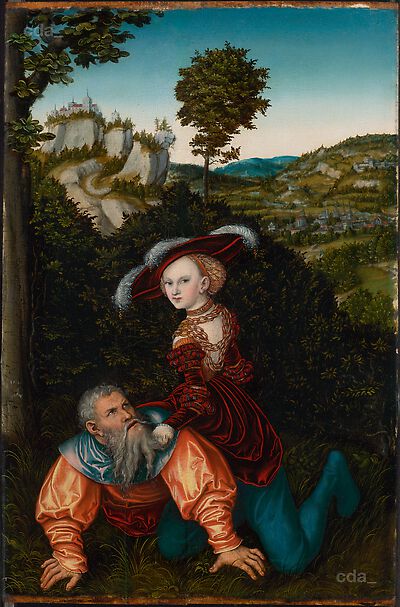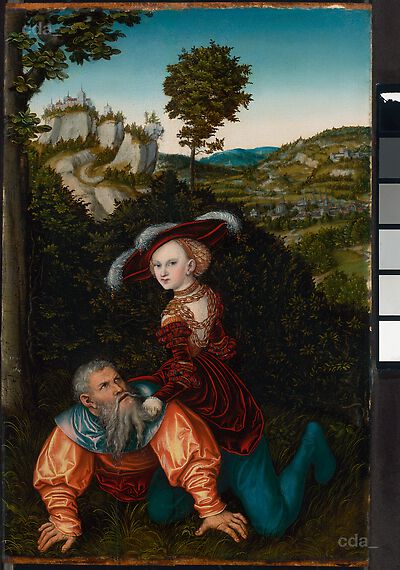The humiliation of the Greek philosopher Aristotle was one of the most powerful and popular pictorial examples of the theme of Weibermacht or the 'Power of Woman' in the late Middle Ages. Although Indian in origin, the legend was popularised by the 13th century cleric Jacques de Vitry in his
The humiliation of the Greek philosopher Aristotle was one of the most powerful and popular pictorial examples of the theme of Weibermacht or the 'Power of Woman' in the late Middle Ages. Although Indian in origin, the legend was popularised by the 13th century cleric Jacques de Vitry in his Sermones feriales et communes, and by Cranach's day had been treated in various texts and in a German 15th century play, Ain Spil von Maister Aristotiles. Although payment is recorded in 1524 for a decorative painting by Cranach of this subject on cloth for the Castle of Lochau in Saxony, the present painting appears to be the only surviving panel painting of this subject. Previously unrecorded it represents an addition of enormous importance to one of the central themes in Cranach's oeuvre.
Aristotle is supposed to have admonished his student, usually identified as the young Alexander the Great, for paying too much attention to Phyllis, a woman of the court, and thus paying too little attention to his studies and state duties. Phyllis, angered by Aristotle's interference, decided to revenge herself by seducing him. By promenading suggestively in the garden beneath Aristotle's window, she succeeded in arousing the aged philosopher. The focal point of the narrative usually illustrated is when, as here, in return for the promise of her favours, Phyllis demands and receives a ride on the philospher's back. Aristotle's humiliation thus provides a salient lesson about the spiritual and physical vulnerability of even the most learned philospher.
Aristotle and Phyllis was one of the several stories illustrating the power of woman over men which enjoyed great popularity in medieval art and literature. Cranach's depiction of the subject differs from that of his contemporaries in several ways. Cranach has in fact dispensed with several basic narrative elements in order to focus on the psychological relationship between the two protagonists, alone in a landscape, emphasizing the contrast between the elegant courtly female and the anguished scholar.
[Sotheby's online database;http://www.sothebys.com/en/auctions/ecatalogue/2008/important-old-master-paintings-including-european-works-of-art-n08404/lot.78.html?locale=en; accessed 20-03-2019]
- Attribution
- Lucas Cranach the Elder
Attribution
| Lucas Cranach the Elder | [Sotheby's online database;http://www.sothebys.com/en/auctions/ecatalogue/2008/important-old-master-paintings-including-european-works-of-art-n08404/lot.78.html?locale=en; accessed 20-03-2019] |
- Production date
- 1530
Production date
| 1530 | [dated] |
- Dimensions
- Dimensions of support: 55.3 x 35.3 cm
Dimensions
Dimensions of support: 55.3 x 35.3 cm
[Sotheby's online database;http://www.sothebys.com/en/auctions/ecatalogue/2008/important-old-master-paintings-including-european-works-of-art-n08404/lot.78.html?locale=en; accessed 20-03-2019]
- Signature / Dating
Artist's insignia on the tree trunk at the left: serpent with elevated wings, facing right and dated '1530'; in white paint
Signature / Dating
Artist's insignia on the tree trunk at the left: serpent with elevated wings, facing right and dated '1530'; in white paint
[cda 2019]
- Owner
- Private Collection
- Repository
- Private Collection
- CDA ID
- PRIVATE_NONE-P270
- FR (1978) Nr.
- FR-none
- Persistent Link
- https://lucascranach.org/en/PRIVATE_NONE-P270/

